Equine
Breeding for Maximum Fertility
- Since man has decided that Jan 1st is the
universal birthday for all horses in the Northern Hemisphere, man's
breeding season for the horse is different than the mare's breeding
season.
- Horse owners desire foals to be born as close
to Jan 1st as possible so they are bigger within their age group when
young. (Even though it has been shown that there is no increased
economic benefit in the lifetime of the horse.)
- This creates breeding problems by forcing
breeding into the non physiologic breeding season, but keeps
theriogenologists employed!
Records
- Records of foaling, palpation, teasing,
breeding are essential in maximizing efficiency.
- Use the records to calculate reproductive
parameters such as breedings/conception, heat cycles/conception,
dates of conception, and foal heat conception.
- Keeping good records allows identification of
problems before a catastrophe strikes without you being aware of it.
Breeding
- The three most important words in horse
breeding are Tease! Tease! Tease!
- You must detect heat to breed efficiently and
teasing is essential to detect heat.
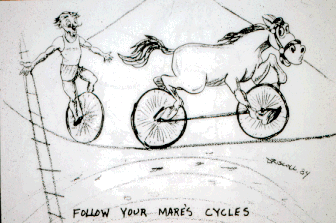
Following a mare's cycles with teasing.
- Even though there is no homosexual behavior
(riding) like cows in horses, estrus detection in horses in easier
than cows because of the longer duration of estrus.
Teasing Systems
- You must use a stallion to tease efficiently. A
'proud cut' gelding is not an efficient teaser. Shetland studs work
well because they are small and very ......shall we say, sexually
aggressive.
- The stallion will give a typical flehman
response when exposed to an estrual mare.
Individual teasing
- This is done one mare at a time and is very
time consuming, but is the best way to accurately detect estrus.
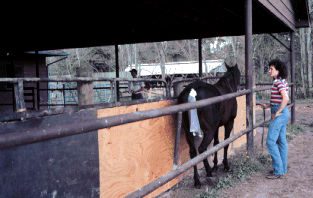 
- Tease head to head, then the stallion's head to
the mare's tail.
- A teasing rail and a race or alley can be
designed to tease many mares in a short time.
Modified individual teasing
- A group of mares is allowed contact with a
stallion, so many mares/stallion are exposed.
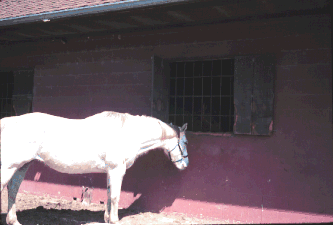
Mare coming to a stall window where stallion is housed.
- The mares may confined and the stallion free to
roam and find the mares in heat or the stallion may be confined and
the mares seek the stallion.
- Shy mares may not show estrus very well in this
type of teasing system.
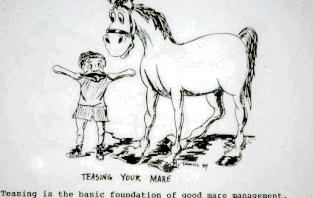 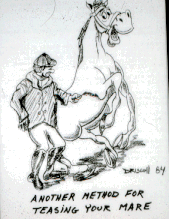
Another way to tease!
How often should you tease ?
- Daily teasing is best, but is really not
needed. Tease at least every other day. We normally tease on
Mondays, Wednesdays, and Fridays and have good heat detection.
- It is important to tease all the mares that may
come into heat, not just the ones you think should be coming into
heat.
- Tease all the mares into heat, through heat and
safely out of heat and into pregnancy until pregnancy is safely
confirmed.
Breeding techniques
Natural

- Natural service is required by some breed
associations (such as the Jockey Club)
- Breeding should be done ideally at ovulation,
but this requires frequent palpation during estrus.
- If the stallion power is available breeding
every other day until the mare is out of heat will work well.
- If you breed early in the year however, you may
exhaust the stallion with no pregnancies breeding transitional
mares.
- A common practice is to start breeding on the
second day of heat and breed every other day.
- Since this does require more stallion power,
you will need to depend on a breeding soundness examination of the
stallion and record analysis to keep the breeding running
efficiently.
- Many popular Thoroughbred stallions breed twice
a day (sometimes three times a day) during the peak season with good
results.
- Libido sometimes becomes a concern
- This is a case where you may need to
'desynchronize' the mares so you do not have as many mares in heat
all at once.
- If there are too many mares for the stallion to
breed, you may need to palpate and breed only at ovulation, but this
takes skill by the veterinarian.
- Natural breeding is more dangerous to all
involved, including the stallion, mare and handlers.
- Natural breeding also allows contamination of
the mare and stallion and spread of venereal disease.
Artificial Insemination (AI)
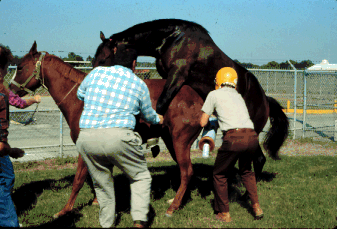
Collecting semen for artificial insemination.
Advantages of AI
- With AI there is less chance of venereal
disease spread,
- You can spread out the stallion to more mares.
- You can collect semen using a dummy mount,
which won't kick the stallion.
- You can evaluate the semen for each breeding.
- You can use a Minimum Contamination Technique (MCT),
which decreases the introduction of contaminants into the mare. With
this technique you put antibiotics in the semen extender, or if
breeding Thoroughbreds, you place extender into the uterus of the
mare that is being bred naturally.
Technique
- Tease the mares into heat.
- Palpate and/or ultrasound for a 35 mm follicle.
- Collect semen from the stallion and inseminate
a minimum of 500 million normal, motile cells into the uterus. The volume of
the insemination is not important ( at least if it less than about
100 ml), only that there are enough motile sperm cells.
- You can use fresh or extended semen.
- Up to 20 inseminations/ejaculate are possible
from some stallions.
Chilled semen
- Many breeds (of course not the Thoroughbreds)
allow the use of chilled, extended, transported semen.
- To inseminate mares using chilled semen they
are usually palpated daily and the day of ovulation is predicted by
the softness of the follicle and the ultrasonic appearance. When you
feel the follicle is about 2 days before ovulation, you order semen.
They usually will collect the same day and ship it to arrive the
next......hopefully. This means semen will come the day before she
ovulates and everything will be perfect! Not so!!!! Many times the
stallion collection schedule does not work out, for example, you
need the semen tomorrow and they have already collected him today
and shipped all the semen out. The next collection will not be until
the day after tomorrow. Now you have a mare ready to ovulate and no
semen coming.
- An easier way is to palpate/ultrasound until a
30-35 mm follicle is present, order the semen and give hCG after the
semen is in the mare. We usually wait until the semen is in the mare
before giving hCG, because there are many instances you give hCG
before getting the semen and then something delays the semen. Now
what? The mare is going to ovulate and you have not semen.
- Inseminate 500 million normal motile cells
- Expect 10% lower fertility with chilled semen
Frozen semen
- Frozen semen requires insemination more closely
timed to ovulation because of the reduced longevity of the sperm.
- Mares are typically palpated every 6 hours and
bred as soon as ovulation is detected. Breeding is done after
ovulation using frozen semen because the sperm cells undergo
capacitation during the freeze/thaw process. This limits their
longevity within the mare.
- If semen supplies are plentiful, bracketing
ovulation, i.e. breeding before anticipated ovulation and again
after, may be practiced
- For example, give hCG when a follicle >
35 mm is present, AI 24 and 40 hr later
- Expect about a 20% reduction in fertility with
frozen semen
Mare Management
- Pre-breeding exam
- Ultrasonography
- Fluid Prebreeding:
Estimate quantity - if seems
excessive - vaginal speculum exam, cytology
- If cytology positive, treat accordingly
(antibiotics, lavage)
- If cytology negative - oxytocin, lavage, or no
treatment
- Vaginal exam
- Culture AND cytology
- Predicting ovulation
- Timing insemination
- Inducing ovulation: Timing?; Agent?
- Artificial Insemination
- Fresh (on farm) semen
- Fresh (cooled shipped) semen
- Semen arrival
- Check motility after warming small
sample
- Semen inseminated directly into mare
- No pre-warming
- Inseminate ALL semen received
- Check
concentration
- Frozen semen
- Thaw according to directions and inseminate
- After Breeding
- Check for ovulation
- Check for fluid
- Normal mares have fluid up to 6 hrs - Fluid
at 12 hrs warrants treatment
- Fluid post breeding - Treat
- Note: post breeding, not necessarily post
ovulation
- Oxytocin, cloprostenol, lavage, exercise, + antibiotics if
> 24 h
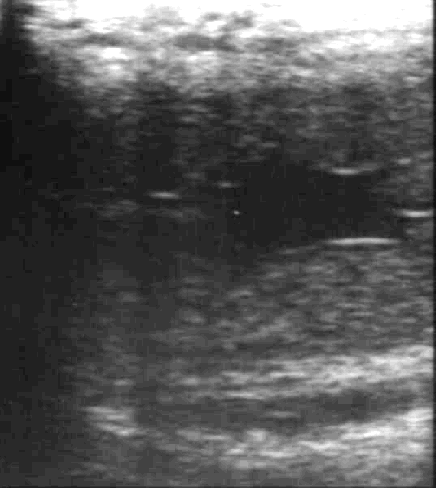 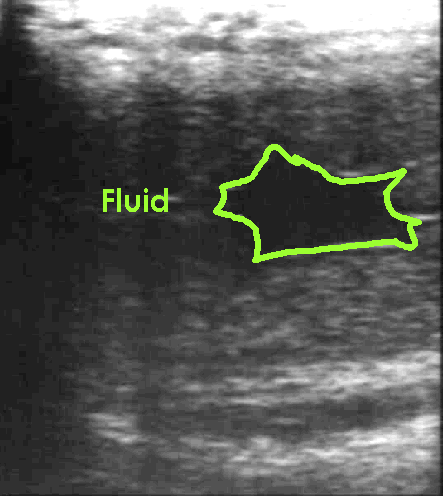
- Fourteen day pregnancy examination
- Predict return to estrus
- Detect “short cycling”
- Detect twins
Breeding Herd (band)
Maiden
- Post pubertal mares are 15-18 months and are
usually maiden mares (1st time bred).
- If the mares are less than 5 years old, you can
expect about a 75 % foaling rate, but these mares are making their
fertility history.
- Some may be 'hot off the track' and be a
handful to breed and may not cycle well for a year.
Foaling mares (wet, lactating, nursing)
- This is the group with the highest fertility,
because they have proven themselves by having a foal at their side.
- Foal heat is generally around at 9 days
postpartum, but may be as early as 5-6 or as late as 12.
Should you breed or not at foal heat ??
- Foal heat breeding is good in that you can
easily detect the estrus, whereas subsequent heats may be harder to
detect.
- Foal heat breeding also keeps the mare foaling
earlier in the year, if that is desired.
- Yes if the mare had a normal foaling and
postpartum period (and didn't foal too early n the year).
- The pregnancy rates on foal heat breeding are
dependent on when a mare ovulates postpartum. This is because the
mares that ovulate early do not have uterine involution that is as
complete, so conception rate is lower.
- If foal heat ovulation is on day 5-6 postpartum the
conception rate is 0%, if it is on day 7-8 postpartum it is about
32%, if it is on days 9-12 postpartum conception rate is about 60%,
and if it is grater than 12 days postpartum conception rates run
greater than 75%.
- Conception rates are definitely lower if fluid is
observed in uterus on ultrasound examination. Do not breed if fluid
is observed.
- The chances for early embryonic death are not
greater if breeding is done on foal heat.
- The fertility of the next heat cycle is not
adversely affected if the mare does not become pregnant.
- There is no greater chance of infection by
breeding on foal heat.
Therapies to enhance fertility of foal heat
- In order to get better involution you can delay
foal heat.
- Administer Regumate for 7 days to delay the
onset of foal heat.
- Administer progesterone/estrogen. Delaying the
first postpartum ovulation by giving 8 days of progesterone
treatment improved pregnancy rates (more mares became pregnant when
first ovulation occurred after 15 d postpartum (23/28), than when
first ovulation occurred before 15 d postpartum (6/12), but the
mares become pregnant later than if it was not given.
- Prostaglandin after foal heat to induce another
heat longer after parturition.
- Prostalene (a prostaglandin compound) BID for 10 d postpartum or until
bred, whichever came first resulted in 77% of the treated vs 44% of
controls being pregnant after breeding on the first heat. 67% of the
treated and 29% of the controls were pregnant after breeding on the
second heat.
Other
- You can also use lights on the pregnant mares
to decrease gestation by 10 days, so the mare cycles back earlier.
This would be helpful in mares that are due to foal late in the
year.
- Foal heat breeding is a management decision
only. The time of year the mare foals is an important aspect. If the
foal is born very early, then you may not want to breed on foal
heat. If the mare is due to foal late, lights and foal heat breeding
may help put her back in sync with your program.
Barren mares
- Barren mares are those mares that were open the
previous year.
- Whether or not the mares were bred is an
important question. A mare that foaled late and was held back
and simply not bred, is
not as big a problem as a mare that was bred a gazillion times and
did not get pregnant.
- Try to determine the reason the mare was
barren. Was it an infertility problem, an organic problem
(infection, etc.), a cyclic problem, a management problem, or a
stallion problem.
- This is the second highest fertility group
because at least they have had a foal, and the maidens have not.
- Barren mare tend to be harder to get pregnant.
Mares are funny in that the more they are pregnant the easier they
are to get pregnant. If they are not pregnant for a year or two,
they become more difficult to get pregnant.
|











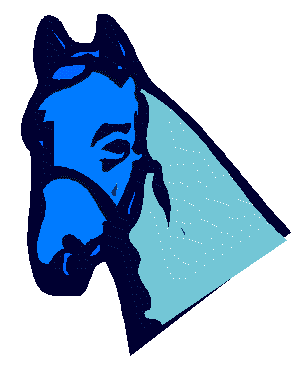 Equine
Index
Equine
Index
